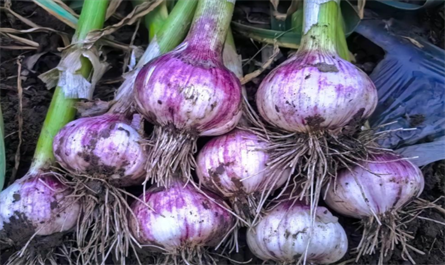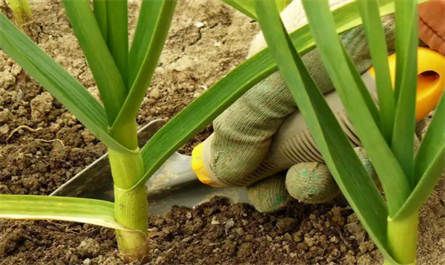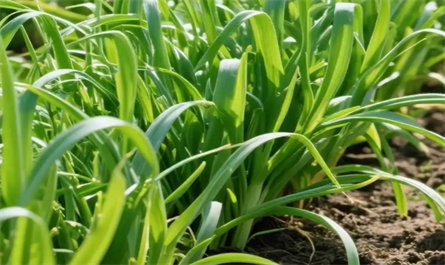Use these plant growth hormone to control plant height and promote strong stems during the jointing period of garlic
The preferred regulators that safely and effectively control plant height and promote strong stems during the jointing period of garlic

1. Paclobutrazol (Paclo) - Most commonly used and most effective
Mechanism of Action: It is a gibberellic acid synthesis inhibitor. It inhibits longitudinal cell elongation, shortening internodes, resulting in a shorter and more robust plant, thicker leaves, and darker leaf color.
Core Benefits:
Effective Growth Control: Effectively prevents excessive growth of garlic stems and leaves.
Promotes underground growth: Allocates more photosynthetic products to the expanding bulbs and elongating stalks.
Enhances lodging resistance: Plants are shorter and more robust, with thicker and stronger stems that are less likely to fall over.
Application:
Use during the early jointing phase, when the pseudostem begins to elongate significantly and has approximately 5-7 leaves. Avoid using too late, as this will excessively inhibit growth.
Use Concentration: Apply 15% Paclobutrazol WP at a 300-500x dilution to the leaves. Always follow the instructions carefully. For initial use, it's recommended to start with a lower concentration (e.g., 500x).
Precautions: Excessive use or spraying too late can result in stunted plants, insufficient photosynthetic area, and ultimately reduced yield. Be mindful of soil residue when following sensitive crops (such as legumes).

2. Chlormequat Chloride (CCC) - A Milder Alternative
Mechanism of Action: Chlormequat Chloride is also a gibberellin antagonist, but its effects are milder than Paclobutrazol.
Core Benefit: Shortens and thickens internodes, thickens leaves, creates a darker green color, and prevents excessive growth.
Application:
Application Period: Same as Paclobutrazol, apply in the early jointing phase when signs of excessive leaf growth are observed.
Concentration: Apply 800-1000 times diluted 50% Chlormequat Chloride solution to the leaves for foliar application.

3. Mepiquat Chloride - A Safer Alternative
Mechanism of Action: Mepiquat Chloride inhibits gibberellin activity in the plant, slowing vegetative growth.
Core Benefit: Mepiquat Chloride controls excessive growth, maintains a compact plant shape, and improves field ventilation and light transmission.
Application:
Application Period: Early jointing phase. Use Concentration: Apply a 1500-2000x dilution of 96%-98% Mepiquat chloride wettable powder to the leaves for foliar spraying.
Advantages: Compared to Paclobutrazol, Mepiquat chloride is milder, has a shorter residual effect, and is safer for subsequent crops.

1. Paclobutrazol (Paclo) - Most commonly used and most effective
Mechanism of Action: It is a gibberellic acid synthesis inhibitor. It inhibits longitudinal cell elongation, shortening internodes, resulting in a shorter and more robust plant, thicker leaves, and darker leaf color.
Core Benefits:
Effective Growth Control: Effectively prevents excessive growth of garlic stems and leaves.
Promotes underground growth: Allocates more photosynthetic products to the expanding bulbs and elongating stalks.
Enhances lodging resistance: Plants are shorter and more robust, with thicker and stronger stems that are less likely to fall over.
Application:
Use during the early jointing phase, when the pseudostem begins to elongate significantly and has approximately 5-7 leaves. Avoid using too late, as this will excessively inhibit growth.
Use Concentration: Apply 15% Paclobutrazol WP at a 300-500x dilution to the leaves. Always follow the instructions carefully. For initial use, it's recommended to start with a lower concentration (e.g., 500x).
Precautions: Excessive use or spraying too late can result in stunted plants, insufficient photosynthetic area, and ultimately reduced yield. Be mindful of soil residue when following sensitive crops (such as legumes).

2. Chlormequat Chloride (CCC) - A Milder Alternative
Mechanism of Action: Chlormequat Chloride is also a gibberellin antagonist, but its effects are milder than Paclobutrazol.
Core Benefit: Shortens and thickens internodes, thickens leaves, creates a darker green color, and prevents excessive growth.
Application:
Application Period: Same as Paclobutrazol, apply in the early jointing phase when signs of excessive leaf growth are observed.
Concentration: Apply 800-1000 times diluted 50% Chlormequat Chloride solution to the leaves for foliar application.

3. Mepiquat Chloride - A Safer Alternative
Mechanism of Action: Mepiquat Chloride inhibits gibberellin activity in the plant, slowing vegetative growth.
Core Benefit: Mepiquat Chloride controls excessive growth, maintains a compact plant shape, and improves field ventilation and light transmission.
Application:
Application Period: Early jointing phase. Use Concentration: Apply a 1500-2000x dilution of 96%-98% Mepiquat chloride wettable powder to the leaves for foliar spraying.
Advantages: Compared to Paclobutrazol, Mepiquat chloride is milder, has a shorter residual effect, and is safer for subsequent crops.
RECENT POSTS
-
Application Effects and Methods of Prohexadione Calcium in Garlic Cultivation
-
DA-6 application methods for potatoes sweet potatoes and ginger during their tuber expansion phase
-
Use these plant growth hormone to control plant height and promote strong stems during the jointing period of garlic
-
Comprehensive Potato Growth Control Plan
Featured News



